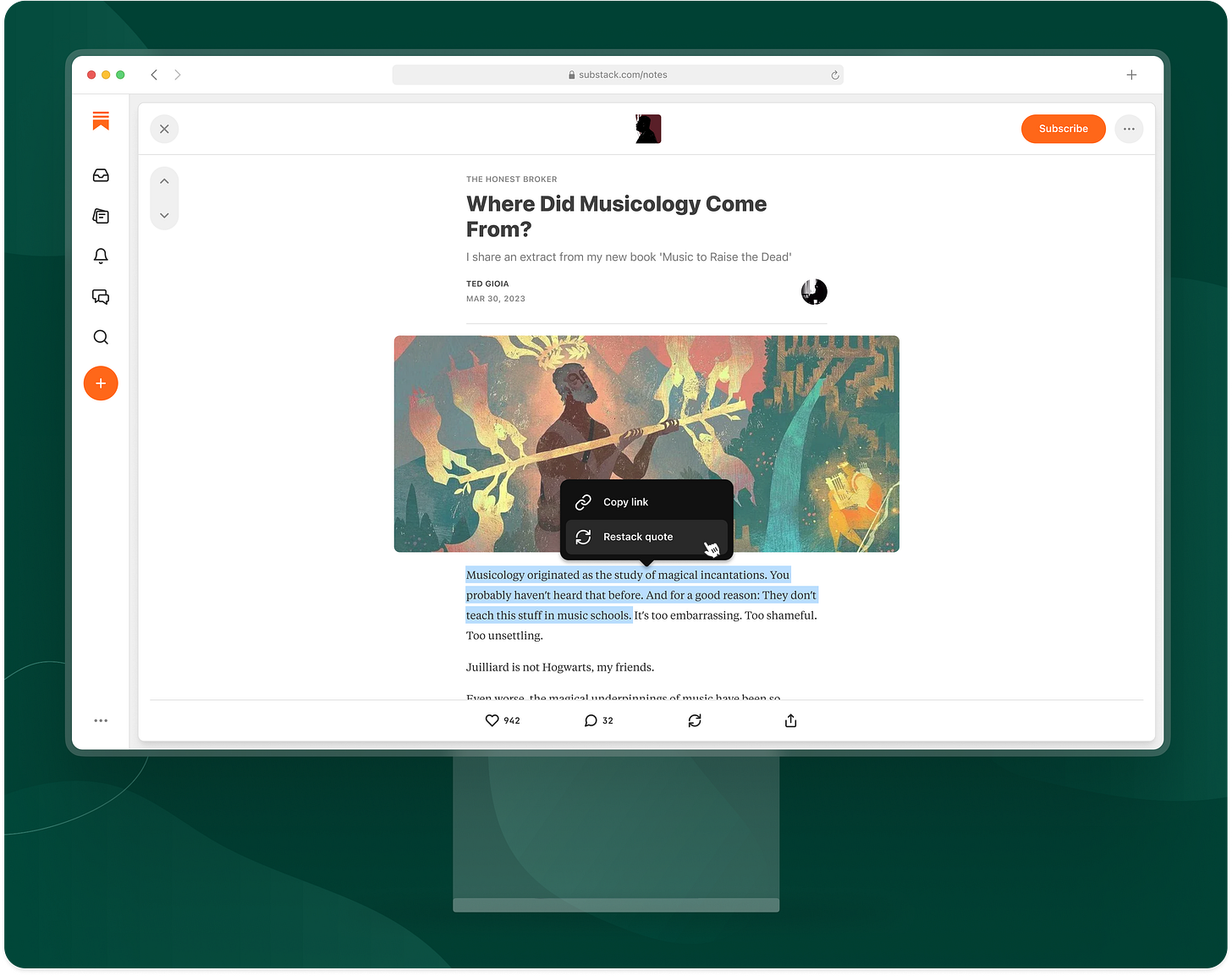As of April 11, 2023, Notes is available to all writers and readers on Substack. Visit Notes.
We started Substack in 2017 because we wanted the internet to be better for writers and readers. We were dismayed with the clickbait and content farms, the listicles and liars, the cheap outrage and culture wars. We thought there could be something better if writers and readers were given more control and treated as a higher priority than advertisers, and if culture makers could find financial dignity without needing to sublimate themselves to attention games and corporate marketing budgets. “We believe that what you read matters,” we said, and we meant it.
So we set about building a system that fosters deep connections and quality over shallow engagement and dopamine hacks. We turned away from advertising and the attention economy and toward subscriptions and direct relationships. We believed that something beautiful could emerge from marrying the internet’s powers with a business model that puts writers and readers in charge, that rewards great work with money, and that protects the free press and free speech. We came to believe that this model—a subscription network—could form the basis of a new economic engine for culture.
There are more than 35 million active subscriptions to writers on Substack, including more than 2 million paid subscriptions. Readers have paid hundreds of millions of dollars to writers on the platform. There has been a Cambrian explosion of great writing, and writers have been saying (unprompted, we promise) that Substack has changed their lives. Encouraged by this early progress, we’ve become excited by the prospect of pushing the subscription network into new territory.
Notes: Post short-form content, recommend anything
In the coming days, we will start rolling out a way for writing, ideas, and discussion to travel through the Substack network. We’re calling this new product Notes.
In Notes, writers will be able to post short-form content and share ideas with each other and their readers. Like our Recommendations feature, Notes is designed to drive discovery across Substack. But while Recommendations lets writers promote publications, Notes will give them the ability to recommend almost anything—including posts, quotes, comments, images, and links. Our goal is to foster conversations that inspire, enlighten, and entertain, while giving writers a powerful growth channel as these interactions find new audiences.
Imagine Kareem Abdul-Jabbar leaving a comment on Margaret Atwood’s note about trends in science fiction, or Alison Roman sharing a quote from an amazing recipe developed by a little-known food writer who then gets a flood of subscriptions. Think of your favorite Substack economists nerding out in a deep thread about the latest jobs report, or Joe Posnanski and Molly Knight going back and forth about Major League Baseball’s Opening Day.
While Notes may look like familiar social media feeds, the key difference is in what you don’t see. The Substack network runs on paid subscriptions, not ads. This changes everything.
The lifeblood of an ad-based social media feed is attention. In legacy social networks, people get rewarded for creating content that goes viral within the context of the feed, regardless of whether or not people value it, locking readers in a perpetual scroll. Almost all the attendant financial rewards then go to the owner of the platform.
By contrast, the lifeblood of a subscription network is the money paid to people who are doing worthy work within it. Here, people get rewarded for respecting the trust and attention of their audiences. The ultimate goal on this platform is to convert casual readers into paying subscribers. In this system, the vast majority of the financial rewards go to the creators of the content.
As we develop Notes, we will focus on building a system that lets people control the contours and boundaries of their subscription universe so that it is easy to keep trolls out and even easier to let valuable contributors in. The goal here is not to create a perfectly sanitized information environment, but to set the conditions for constructive discussion where there is enough common ground to seek understanding while holding onto the worthwhile tension needed for great art and new ideas. It won’t feel like the social media we know today.
Many of us have grown so used to talk of hellsites and doomscrolling—while wondering if social media is driving us mad—that we have forgotten that the internet can be good. Most of us have made friends on the internet, and some have even fallen in love online. It wasn’t that long ago when cancellations and brigading were unknown concepts. There was a time when social media was fun more than frightening. But there’s no going back to the time of Blogspot and LiveJournal. The goal cannot be to Make the Internet Great Again. The incumbents are entrenched, there are more than 6 billion smartphones in circulation, and the AI genie is out of the bottle. But we can go forward.
By changing the rules of engagement—by creating a new media universe with different laws of physics—the internet can be better than it has ever been. We have been living with the worldwide web for only three decades. In that time, most of our media business efforts have revolved around advertising. We see the potential for so much more. While we are reaching the limits of the era of social networks, there is so much rich territory to explore with subscription networks.
We at Substack intend to do a lot of exploring. And we hope you’ll come with us.









